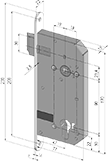Tips and advice
How to pick a suitable lock?
We have to pay attention to a few things when changing a lock or picking a new one.
The measurement of "centres" of the lock is very important when choosing lock fittings.
One of them is the choice of a correct backset and dimension from handle to cylinder. Most manufacturers classify their locks as narrow and wide which directly correlates with the backset and the case depth. We cannot choose a wide lock with a 50 mm backset for a metal door with case depth of 55 mm, since the locks total backset will be at least 80 mm. When it comes to exchanging an old door lock the measurements of the backset and the case depth have to be taken so that there is no need to re-drill. When it comes to new doors we have to measure mainly the case depth.
Before purchasing a new door lock we also have to decide on the manner in which we want it to unlock. We have three options to choose from; a key, an access system, or the access system in combination with a pressed door handle.
If we chose to unlock the lock using an access system then the only things left to do is to choose the electric functions the lock should have, for example if we want the lock to have an acoustic signalisation or micro switch for checking the state of the lock.
What are "centres" dimension and backset?
The "centres"
The "centres" dimension is the millimetre measurement between the centre of the keyhole to the centre of the handle. The measurement is always taken from centre to centre. (see picture) The most commonly used "centres" measurements in the Czech Republic are 92 mm, 90 mm and 72 mm.
Backset
Backset is a millimetre measurement which states the dimensions between the centre of the door handle and the forend of the lock (included) See picture. The most commonly used locks in the Czech Republic are those with centres of 35 mm and 45 mm (for plastic doors) and 50 mm, 55 mm and 65 mm (for wooden doors). It is not exceptional however to use locks with larger or smaller backset on metal doors.
What is the panic function and self-locking?
Panic function
or panic handle is a special property of the lock that allows you to open the door from the inside without the key or access system. It is enough to push the handle which opens the lock. In the EU and therefore in the Czech Republic the norm ČSN EN 179:2008 states the properties of the panic handle during emergency escapes (fire).
Self-locking
is a property of the lock thanks to which you do not need to lock the lock in any way. It is enough to simply close the door and the door is double locked.
Differences between mechanical, electromechanical and motor locks.

Mechanical lock
is used in most cases with a handle/knob fitting because the lock will be fitted with a spindle. The inside always has a panic function and the outside is opened with a key.

Electromechanical lock
In most cases a split spindle is used. The inside has a panic function or an access system and the outside is opened with either a key or with a combination of an access system and a pushed handle..
Two main solenoid versions of the electromechanical lock
Classic - EL / fail secure panic handle is always functional in the escape direction. The outside handle which is controlled by an electric access system is functional when electricity is connected.
Reverse - REV / fail safe panic handle is always functional in the direction of escape. The outside handle which is controlled by an electric access system is functional after the electricity connection is severed.

Motor lock
is used with handle/knob fitting and a spindle. The inside always has a panic function and the outside is opened with an access system.